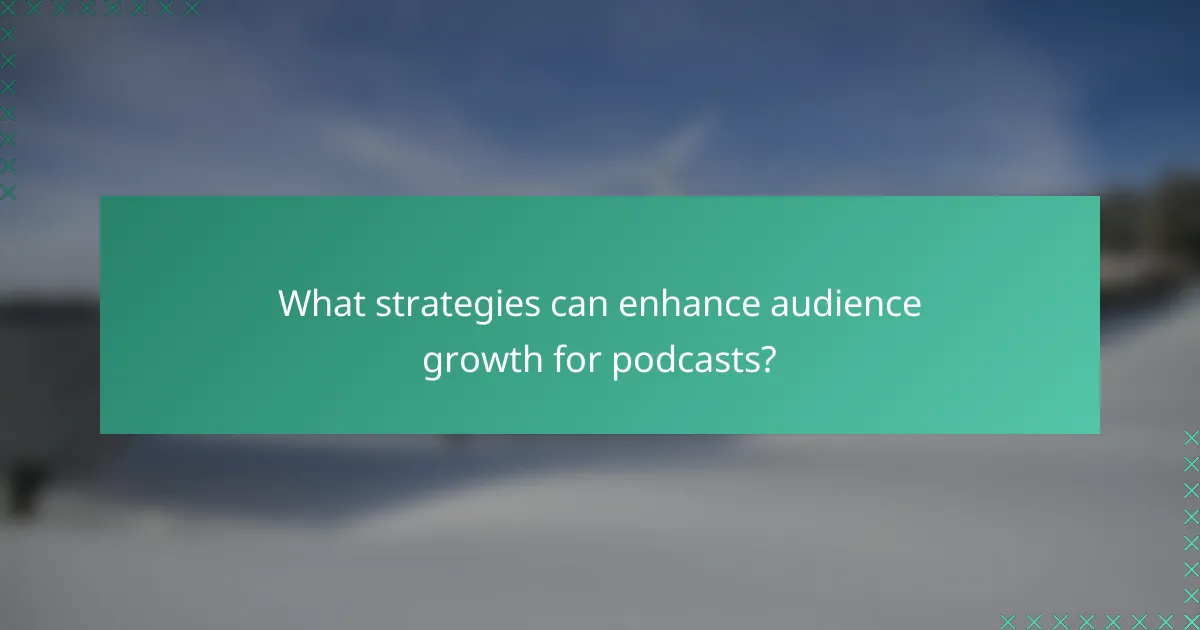Podcasts present a unique opportunity for creators to monetize their content through various strategies such as advertising, listener support, and subscriptions. To successfully grow an audience, it’s essential to implement effective promotion and engagement tactics that foster community loyalty. Additionally, structured content planning can enhance episode development, ensuring consistency and relevance while appealing to listeners’ interests.

How can podcasts be monetized effectively?
Podcasts can be effectively monetized through various strategies, including advertising, listener support, merchandise, subscriptions, and affiliate marketing. Each method offers unique benefits and challenges, allowing creators to choose the best fit for their audience and content style.
Advertising revenue through sponsorships
Advertising revenue is a primary monetization strategy for many podcasts, typically achieved through sponsorships. This involves partnering with brands to promote their products or services during episodes, often in the form of pre-roll, mid-roll, or post-roll ads.
Podcasters should consider their audience demographics when selecting sponsors to ensure alignment. Rates can vary widely, but many creators charge based on CPM (cost per thousand impressions), with rates ranging from $15 to $50 depending on the niche and audience size.
Listener donations via platforms like Patreon
Listener donations can provide a steady income stream through platforms like Patreon, where fans contribute directly to support their favorite podcasts. This model allows creators to offer exclusive content or perks in exchange for financial support.
To maximize listener donations, podcasters should actively engage their audience and clearly communicate the benefits of supporting the show. Offering tiered membership levels can also encourage more contributions, with common ranges from $1 to $10 per month.
Merchandise sales for brand promotion
Merchandise sales can serve as both a revenue source and a marketing tool for podcasts. By selling branded items such as t-shirts, mugs, or stickers, podcasters can promote their brand while generating income.
Successful merchandise strategies often involve creating quality products that resonate with the audience. Pricing should reflect production costs and perceived value, typically ranging from $15 to $30 for apparel items.
Subscription models for exclusive content
Subscription models allow podcasters to offer exclusive content to paying subscribers, creating a premium experience. This can include bonus episodes, ad-free listening, or early access to new shows.
To implement a subscription model, creators should ensure that the exclusive content is compelling enough to justify the cost, often priced between $5 and $15 per month. Clear communication about what subscribers will receive is essential for attracting and retaining members.
Affiliate marketing partnerships
Affiliate marketing partnerships enable podcasters to earn commissions by promoting products or services from other companies. When listeners purchase through a unique affiliate link, the podcaster receives a percentage of the sale.
Choosing relevant affiliate products that align with the podcast’s theme can enhance credibility and increase conversion rates. Commissions typically range from 5% to 30%, depending on the affiliate program, making it a potentially lucrative option for podcasters with engaged audiences.

What strategies can enhance audience growth for podcasts?
To enhance audience growth for podcasts, creators should focus on effective promotion, collaboration, and engagement strategies. These approaches not only attract new listeners but also foster a loyal community around the podcast.
Utilizing social media for promotion
Social media platforms are essential for promoting podcasts and reaching potential listeners. By sharing episode highlights, behind-the-scenes content, and engaging posts, podcasters can create buzz and drive traffic to their shows.
Consider using platforms like Instagram, Twitter, and TikTok to connect with audiences. Regularly posting engaging content can increase visibility and encourage shares, expanding your reach significantly.
Collaborating with other podcasters
Collaborating with other podcasters can introduce your show to new audiences. Guest appearances or co-hosting episodes allow for cross-promotion, where both parties benefit from each other’s listener base.
Choose collaborators whose content aligns with yours to ensure a natural fit. This strategy can lead to increased downloads and a broader listener demographic.
Optimizing SEO for podcast visibility
Search engine optimization (SEO) is crucial for making your podcast discoverable. By using relevant keywords in your episode titles, descriptions, and show notes, you can improve your visibility on search engines and podcast directories.
Consider creating a dedicated website for your podcast where you can post show notes and transcripts. This not only enhances SEO but also provides a platform for additional content, attracting more visitors.
Engaging with listeners through Q&A sessions
Engaging with your audience through Q&A sessions can strengthen listener loyalty and encourage word-of-mouth promotion. These sessions allow listeners to feel more connected and invested in your podcast.
Utilize platforms like Instagram Live or YouTube to host these interactions. Encourage listeners to submit questions in advance, creating anticipation and ensuring a lively discussion.
Leveraging email marketing campaigns
Email marketing is an effective way to keep your audience informed and engaged. By building an email list, you can share episode updates, exclusive content, and personalized messages to foster a deeper connection with listeners.
Consider offering incentives, such as bonus episodes or downloadable content, to encourage sign-ups. Regular newsletters can keep your audience engaged and remind them to tune in to new episodes.

What are effective content planning techniques for podcasts?
Effective content planning techniques for podcasts involve creating a structured approach to episode development, ensuring consistency, relevance, and audience engagement. By utilizing tools like content calendars and audience feedback, podcasters can enhance their content strategy and grow their listener base.
Creating a content calendar for consistency
A content calendar helps podcasters maintain a regular publishing schedule, which is crucial for audience retention. By planning episodes weeks or months in advance, creators can ensure timely releases that align with seasonal trends or special events.
To create a content calendar, outline your episodes, including topics, guest appearances, and recording dates. Consider using tools like Google Calendar or Trello for easy tracking and adjustments.
Researching trending topics for relevance
Staying updated on trending topics ensures your podcast remains relevant and appealing to listeners. Use platforms like Google Trends, social media, and podcast charts to identify what’s currently capturing audience interest.
Incorporate these trends into your content planning by aligning your episodes with popular themes or discussions. This approach can significantly boost your podcast’s visibility and engagement rates.
Incorporating listener feedback into episodes
Listener feedback is invaluable for shaping future content and enhancing audience satisfaction. Actively solicit feedback through surveys, social media, or direct communication to understand what your audience enjoys or wants to hear more about.
Use this information to refine your episode topics, format, and style. Regularly addressing listener suggestions can foster a sense of community and loyalty among your audience.
Defining target audience personas
Defining target audience personas helps podcasters tailor their content to specific listener demographics. Consider factors such as age, interests, and listening habits to create detailed profiles of your ideal audience members.
Once you have these personas, use them to guide your content planning, ensuring that each episode resonates with your intended listeners. This targeted approach can enhance engagement and attract new subscribers.
Utilizing analytics for content improvement
Analytics provide insights into listener behavior, helping podcasters understand what works and what doesn’t. Track metrics such as download numbers, listener retention rates, and engagement levels to gauge the effectiveness of your episodes.
Use this data to make informed decisions about future content, such as adjusting episode lengths or exploring new topics. Regularly reviewing analytics can lead to continuous improvement and a more successful podcast.

What criteria should be considered for selecting podcast topics?
Selecting podcast topics requires careful consideration of audience interest, engagement potential, and alignment with your brand’s values. These criteria help ensure that your content resonates with listeners and supports your overall mission.
Audience interest and engagement potential
Understanding your audience’s interests is crucial for selecting podcast topics that will engage them. Conduct surveys, analyze social media trends, and review popular content within your niche to gauge what resonates with potential listeners. Aim for topics that spark curiosity and encourage interaction.
Consider the format and depth of the content as well. For instance, lighter topics may attract a broader audience, while niche subjects can foster a dedicated following. Balance your choices to maintain listener interest over time.
Alignment with brand values and mission
Your podcast topics should reflect your brand’s core values and mission to create a cohesive identity. This alignment helps build trust and loyalty among your audience. For example, if your brand emphasizes sustainability, focus on topics related to eco-friendly practices or innovations.
Additionally, ensure that your podcast content supports your business goals. Whether it’s driving sales, increasing brand awareness, or establishing thought leadership, select topics that contribute to these objectives while staying true to your brand’s essence.
